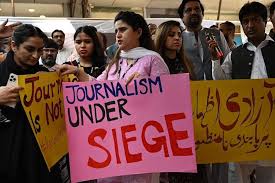Pakistan’s deadliest year for journalists unveiled

The year 2024 stands as one of the most perilous for journalists in Pakistan, with multiple targeted killings and a staggering 57 recorded violations against media practitioners, according to Freedom Network’s Impunity Report 2024.
The alarming data reveals six journalists and a YouTuber lost their lives, while at least 57 incidents, including threats, assaults, and legal harassment, were reported. The report highlights the continued impunity for such crimes, exacerbated by provincial authorities’ inaction.
Despite federal and Sindh laws meant to protect journalists, there has been little impact in combating impunity.
“Despite the enactment of the Sindh Protection of Journalists and Other Media Practitioners Bill 2021 and the federal Protection of Journalist and Media Professional Act 2021, neither the federal nor the Sindh governments have effectively enforced these laws,” stated Iqbal Khattak, Executive Director of Freedom Network, on the eve of International Day to End Impunity for Crimes against Journalists.
The report, which covers incidents between November 2023 and August 2024, documents 11 assassination attempts, including five fatal attacks on journalists and digital media practitioners. It also notes the distribution of these threats across provinces, with Sindh leading in violations (37%), followed by Punjab (23%), Islamabad (21%), Khyber Pakhtunkhwa (12%), and Balochistan (3.5%).
Television journalists bore the brunt, accounting for 53% of violations, followed by print journalists (35%), digital media (10%), and radio journalists (2%). Female journalists also reported 9% of the total cases, underscoring the scope of gender-based risks in the field.
The report introduces Pakistan’s first-ever “Media Impunity Index,” measuring each region’s progress in creating protective frameworks.
Sindh ranked highest with nine points out of 10, reflecting its legislative efforts, while the federal government scored eight. However, the absence of active safety commissions has hampered any real protection. Punjab scored the lowest, with just one point, highlighting its lack of action for journalists’ safety.
Courts, including the high and supreme courts, have occasionally intervened, offering some protection for journalists charged under controversial cases, often involving state actors. These judicial interventions offer a faint ray of hope amid a grim reality.
The report concludes that addressing impunity is vital for safeguarding media freedom in Pakistan. With an average of six violations per month against media practitioners, an urgent, coordinated response from the state, media, and civil society is necessary.





